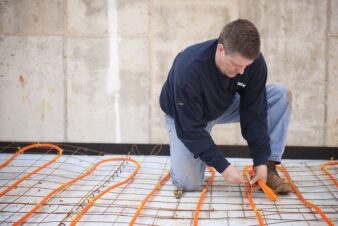AWE, PMI research focused on residential properties in Arizona, California, Colorado, Georgia and Texas
Chicago —Water-efficient toilets could potentially save up to 170 billion potable gallons of water per year across five states facing water scarcity, according to new research released today by the Alliance for Water Efficiency (AWE) and Plumbing Manufacturers International (PMI).
The “Saturation Study of Non-Efficient Water Closets in Key States” focused on Arizona, California, Colorado, Georgia and Texas – all states that have experienced serious water shortages. The savings projected by the study (170 billion gallons of potable water yearly or 465 million gallons saved per day) could be achieved if non-efficient toilets in residential properties are replaced with water-efficient ones. This five-state savings can be extrapolated to an estimate of up to 360 billion potable gallons of water per year saved nationally.
This research produces important direction for water managers nationwide, as 40 out of 50 states anticipate water shortages in the coming years, according to a Government Accountability Office survey of state water managers published in 2013, with most of these states already experiencing periodic shortages. The five states researched represent 28 percent of the national population and 47 percent of all housing units in 2015, so the report examines a large part of the residential water consumption in the United States. Toilet flushing is the largest single indoor use of water, representing 24 percent of total use in single-family homes. Replacing non-efficient toilets with efficient ones is an important strategy to stretch available water supplies.
“This study affirms the important and sometimes overlooked role that water-efficient plumbing products – and programs such as the EPA WaterSense label – play in assuring water sustainability for our nation,” said Mary Ann Dickinson, AWE president and CEO. “We are nowhere near the potential of water savings we can achieve through water efficiency.”
Barbara C. Higgens, PMI CEO/executive director, said plumbing manufacturers are proud of the water-saving innovations they have brought to the marketplace. “Great water-efficiency innovations have already been made and are readily available. Now, it’s time for consumers and businesses to do their part to replace non-efficient toilets, showerheads and faucets with water-efficient ones,” she stated.
Non-efficient toilets defined as those using more than 1.6 gallons per flush
The five-state water savings estimate was calculated after the study’s research determined that more than 13 million non-efficient toilets, with gallons per flush (gpf) of more than 1.6 gallons, remain installed in Arizona, California, Colorado, Georgia and Texas residences. These 13 million toilets comprise about 21 percent of all toilets installed in these states; therefore, about 79 percent of installed residential toilets in these states are already efficient at 1.6 gpf or less.
Using the AWE/PMI study estimate of 170 billion gallons of water, these examples – illustrated in this infographic – show how much water can be saved within residential properties located in the five states included in the study:
- Enough water saved to take 10 billion showers – more than one for each person on the planet
- Enough water saved to serve the indoor home water needs of a city of 100,000 for 45 years
- Enough water saved to fill 250,000 Olympic-sized swimming pools
- Enough water saved to fill 1,000 Rose Bowls
- Enough water saved to equal the water that goes over Niagara Falls in 2 1/2 days
Current water-saving technology can make a tremendous impact
The AWE/PMI study demonstrates that current plumbing technology can make a tremendous water-saving impact, especially if toilet replacement programs can be accelerated. At the current 4 percent annual toilet replacement rate, the potential savings illustrated in this study will not occur for another 15 to 30 years unless replacement programs are accelerated.
This study’s results also merit consideration within the current federal and state regulatory environment. At the federal level, proposed cost cutting at the Environmental Protection Agency threatens the WaterSense program, a voluntary public-private partnership initiative to encourage the use of water-efficient toilets, showerheads, faucets and other plumbing products. Through the use of the more than 16,000 WaterSense product models on the market, the nation has already saved more than 1 trillion gallons of water over the past 10 years.
About the Alliance for Water Efficiency
The Alliance for Water Efficiency (AWE) is a North American 501(c)(3) nonprofit organization dedicated to the sustainable and efficient use of water. Based in Chicago, AWE works with nearly 400 water utilities, water conservation professionals in business and industry, planners, regulators, and consumers. As the leading voice for water efficiency, AWE’s platform brings together innovative technical resources to facilitate adoption of water conservation programs, cutting-edge research to address pressing challenges, and a collaborative dialogue amongst stakeholders to further adoption of water conservation programs.www.allianceforwaterefficiency.org.




Join the conversation: